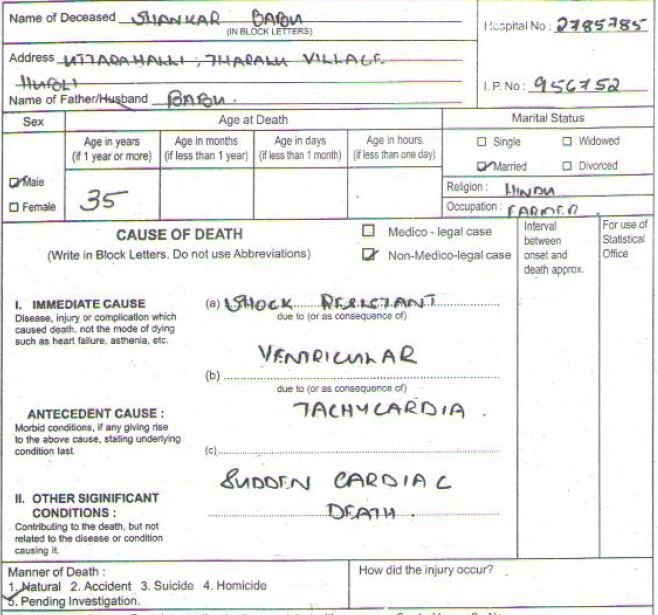Errors in death certificates are classified into:
1. Technical/Clerical Errors
2. Certification Errors
Technical errors happen at the top and bottom of the death certificate
Certification errors happen in Part 1 and Part 2 of the death certificate
Technical/Clerical errors can happen in the top part of the certificate


Technical/Clerical errors can happen in the bottom part of the certificate also

Certification errors happen in Part I and Part II of the certificate
1. Technical/Clerical Errors include:
| Technical or Clerical errors |
|---|
| 1. Filling wrong form (eg. Stillbirths/ brought-dead being filled in the form meant for institutional deaths) |
|---|
| 2.Wrong patient identifiers |
|---|
| 3.Certifying physician details missing/incomplete |
|---|
| 4.Not removing bottom portion for the relatives |
|---|
Technical/Clerical errors that happen in the top part of the certificate include:

| 1. Filling wrong form (eg. Stillbirths or brought-dead being filled in the form meant for institutional deaths) |
|---|
| 2.Wrong patient identifiers |
|---|

Technical/Clerical errors that happen in the bottom part of the certificate include:
| 3.Certifying physician details missing/incomplete |
|---|
| 4.Not removing the bottom portion for the relatives |
|---|
2. Certification Errors - Based on the type of error, this can be further classified into:
| Type of Error |
|---|
| Major Error 1.Mechanism of death listed without an underlying cause 2.Improper sequencing 3.Competing causes of death |
|---|
| Minor Error 1. Abbrevations 2.Absence of time intervals 3.Mechanism of death followed by a legitimate underlying cause of death |
|---|
These errors will be described in the next set of real death certificates filled in hospitals.
The errors in this certificate are:

Errors in this certificate -
1. Competing causes of death
2. Use of abbreviations
Cause of death written on the last line of the certificate [1(c)] is Underlying CoD. Here, in 1(c),the competing causes of death include low birth weight, RDS, perinatal asphyxia, ARF,RDS etc. It is important to write a single CoD and not multiple causes as Underlying CoD.

The errors in this certificate are:
Errors in this certificate -
1. The entry in line (a) is illegible
2. ?diagnosis is acceptable in the hospital while the person is still alive; but once death has occurred, clinical judgement is to be used to arrive at a single probable cause of death and therefore ? mark is not needed
The error in this certificate is:

Error in this certificate -
1. The entry in line (a) is illegible

The errors in this certificate are:
Errors in this certificate -
1. Incomplete details of accident
2. Use of abbreviations

The error in this certificate is:
Error in this certificate -
If only a single diagnosis is written, that will be taken as the underlying CoD [i.e. the last filled line among lines a, b or c in Part I is considered the uCoD]. So in this example, septicemia is the only filled diagnosis. Septicemia is a non-specific cause (or) only an immediate CoD and not underlying CoD. For the death certificate to be valid/complete, the underlying CoD should be filled in line b or line c below.

The error in this certificate is:
Error in this certificate -
This is an example of Major error : Mechanism of death listed without an underlying cause. Failure to construct a chronological sequence of events and listing a mechanism/mode of death as the CoD (underlying, intermediate and immediate) is not useful.

The errors in this certificate are:
Errors in this certificate -
1. ? Brain cannot be a uCoD
2. Brain causing intracerebral hemorrhage causing chronic bronchitis leading on high BP, IHD & DM is not a biologically-plausible sequence of events
3. High BP, IHD & DM are competing causes of death (more than one disease cannot be listed on same line; each disease should be listed on a separate line); IHD should be listed in Part 1 while DM & HT should be listed in Part 2

The error in this certificate is:
Error in this certificate -
While the intermediate and immediate causes of death have been listed, the underlying cause (whether road accident or slip & fall on the same surface or fall from a height or crush injury, etc) has not been identified as uCoD in line c of Part I

The errors in this certificate are:
Errors in this certificate -
1. Competing causes with no biologically-plausible sequence of events
2. Diabetes to be listed in Part 2

The errors in this certificate are:
Errors in this certificate -
1. Wrong sequence
2. Use of abbrevation

The error in this certificate is:
Error in this certificate -
Mechanism of death with no Underlying Cause of death

This is a good example to show that 'Burns' is not a natural cause of death ; but should be checked as one of 2 to 5 under manner of death.
Lessons from previous examples
-
These wrongly filled examples show us that these death certificates are not useful to:
-
If untimely deaths are to be prevented, the chain of events have to be interrupted or a cure initiated at some intermediate point
- Either the government/health authority in terms of identifying the causes of death in these hospitals in a region
- Or the doctors in terms of identifying the sequence of events for intervention at specific points along the biologic pathway with appropriate diagnostic/therapeutic interventions
-
The public health objective is to prevent the precipitating cause from operating and hence the relevance of the underlying cause